Reserve Bank of Australia Annual Report – 1996 Developments in Financial Intermediation
The pace of financial intermediation gathered momentum in 1995/96, with lending for business leading the way, but housing and personal lending remaining buoyant.
Patterns of intermediation
Total credit – that is, the sum of loans and advances provided by all financial intermediaries and bank bills outstanding – grew by over 12½ per cent over the course of 1995/96, its fastest growth since 1989/90. Borrowing for business, housing, and other personal purposes each grew at a broadly similar pace last year but the mix has changed markedly over recent years. Housing credit grew very rapidly in 1993 and 1994, before slowing to around 12 per cent per annum, with growth being supported by lending for established houses and especially investment housing, for which loan approvals grew by about 17 per cent over the past year. Business lending – which amounts to just over half of total outstanding credit – has taken over the running as the growth in housing lending has slackened.
Financial aggregates
(12-months-ended percentage change)
| June 1990 |
June 1991 |
June 1992 |
June 1993 |
June 1994 |
June 1995 |
June 1996 |
|
|---|---|---|---|---|---|---|---|
| Monetary aggregates | |||||||
| Currency | 5.4 | 13.9 | 4.0 | 6.9 | 6.7 | 5.5 | 3.1 |
| M1 | 3.7 | 9.6 | 13.9 | 16.2 | 15.8 | 2.5 | 12.1 |
| M3 | 12.6 | 6.2 | 2.4 | 6.4 | 6.7 | 6.7 | 9.4 |
| Broad money | 8.2 | 1.7 | 1.4 | 4.1 | 6.4 | 7.1 | 10.3 |
| Credit | 11.0 | 1.9 | −1.4 | 2.0 | 7.6 | 9.7 | 12.6 |
| Housing | 9.9 | 8.8 | 12.3 | 18.1 | 22.9 | 15.9 | 11.7 |
| Personal | 8.4 | −2.8 | −5.2 | −0.7 | 4.2 | 9.9 | 9.7 |
| Business | 12.0 | 0.4 | −5.9 | −4.8 | −0.4 | 5.3 | 13.9 |
Between 1990 and 1994, businesses reorientated their balance sheets to correct over-geared positions associated with the asset price inflation of the late 1980s. With this period of balance-sheet adjustment behind them, and investment spending on the rise, businesses began tentatively to expand their debt in 1994/95 and, more vigorously, in 1995/96. Early in the upswing, businesses relied mainly on internal sources of funding but, as these sources became insufficient for their growing funding needs, they turned to external finance. Both equity and debt have been drawn upon heavily over the past year, to the point where internal sources of funding, debt and equity, have grown more or less in line with their longer-term relativities; credit, for example, amounted to around 40 per cent of total funding by the first half of 1996, close to its average in the 1980s.
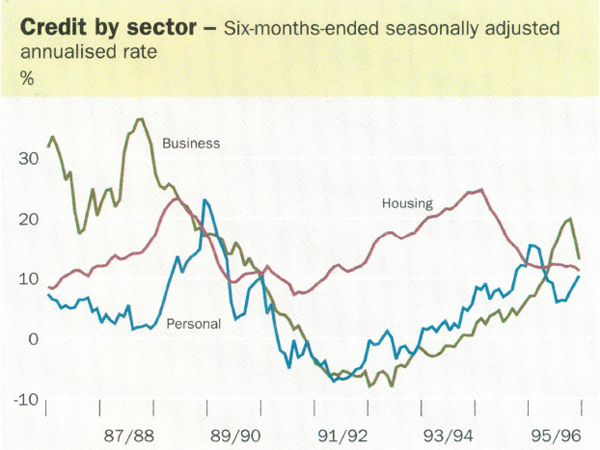
Another factor encouraging greater reliance on debt over the past year was a slight fall in profits, following strong growth earlier in the upswing. Despite higher borrowing levels, however, corporate debt-servicing burdens remain moderate, reflecting lower interest rates as well as lower levels of gearing. For corporates, debt-servicing is about 30 per cent below its average level over the past 15 years. but in the unincorporated sector there has been little change.
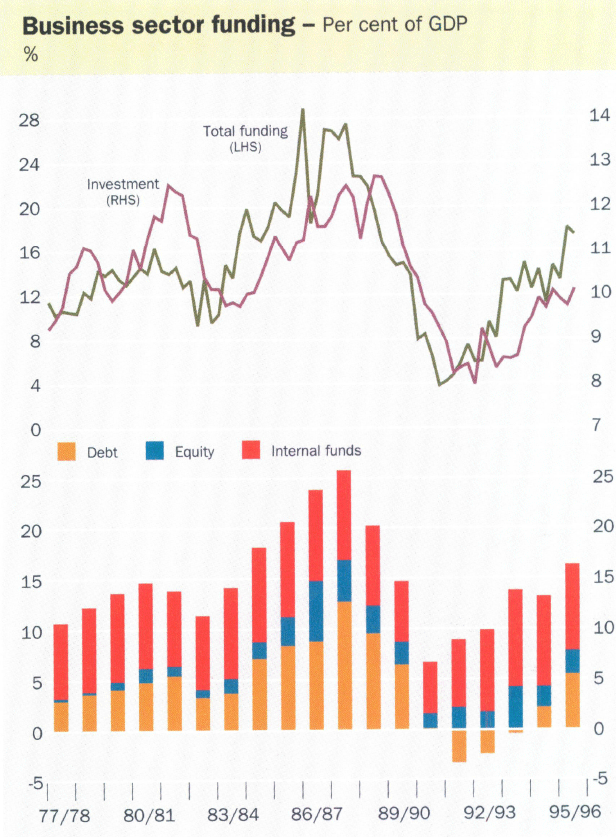
Along with stronger borrowing from intermediaries, businesses also made substantial recourse to capital markets in 1995/96, especially in the equity market, where $11 billion was raised compared with $9.5 billion the previous year. The domestic corporate bond market remained small, with only asset-backed securities recording strong growth; most of these were mortgage-backed bonds, which grew by $2 billion (30 per cent), reflecting the success of mortgage managers in expanding their share of the home loans market.
Corporate cash flows
(Per cent of gross operating surplus)
|
Average 1980/90s % |
March quarter 1996 % |
|
|---|---|---|
| Net interest payments by private corporate enterprises | 25.7 | 18.0 |
| Net interest payments by unincorporated enterprises | 20.3 | 20.0 |
Credit provided by banks to small businesses rose by around 9 per cent over the year to the March quarter, somewhat slower than the growth in total business credit. The proportion of banks' small business credit provided at fixed rates has increased further, to just under 40 per cent at end March 1996. Banks and other lenders launched a range of new lending products aimed at smaller businesses, including products for cash flow lending, rural finance and franchising, as well as facilities with “honeymoon” rates for growth firms. On the whole, surveys continue to show that most small businesses do not regard the availability of finance as a major problem.
Housing finance
Non-traditional lenders have turned up the heat in the housing loan market during the past year. Mortgage managers accounted for about 9 per cent of the market for new loans, compared with 2 per cent two years ago. For most of the year banks sought to counter this competition with offers aimed only at new customers, thereby isolating their larger body of existing customers from more attractive but less profitable products. These included:
- “Honeymoon” loans, which offer a lower interest rate for the first year of the loan before reverting to the standard variable rate. These accounted for about half of banks' new loans during the year. (These loans typically carry substantial exit fees to discourage borrowers from switching out of the loans at the end of the first year.)
- “No frills” loans at rates substantially below the standard variable rate but with reduced flexibility in terms of repayments and other conditions. In some cases, these were offered through a subsidiary to protect the brand franchise of the bank's own standard loans.
- Fixed-rate loans for between two and five years offered at competitive rates, with narrow margins over the cost of fixed-rate funds in wholesale markets. The share of fixed-rate loans rose from 11 per cent in June 1995 to 19 per cent in May 1996.
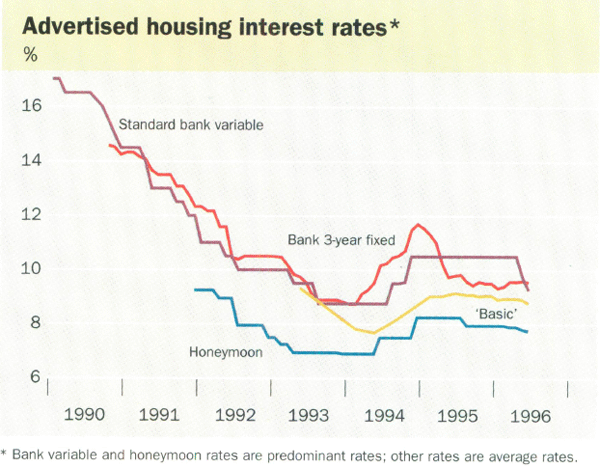
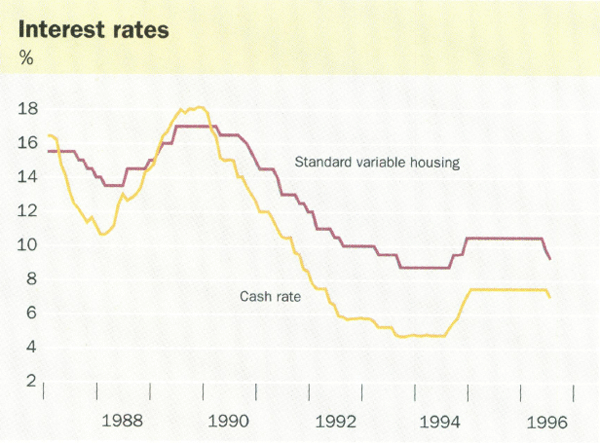
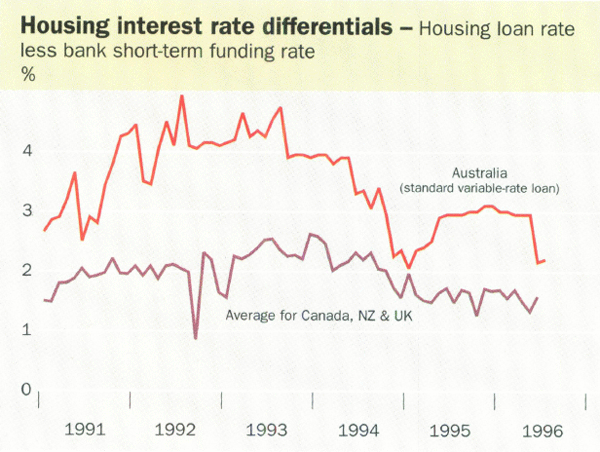
By the middle of 1996 the standard variable-rate loans became the focus of competition. The interest rate on these loans in the past has tended to change only when official interest rates have changed and, accordingly, had been unchanged at 10.5 per cent since early 1995. When one major bank announced a reduction in this rate to 9.9 per cent in early June 1996 other banks followed quickly. Another round of cuts to 9.75 per cent occurred later in the month. Lenders made further reductions in rates on housing loans (generally in the order of 0.5 per cent) following the easing of monetary policy in late July. In addition to these changes, many banks eliminated the premium (of about one percentage point) which they had been charging on housing loans undertaken for investment purposes, rather than for owner occupation.
The recent reductions in the standard variable rates reversed the bulk of the increase which occurred in late 1994/early 1995 following the tightening in monetary policy. The spread between the interest rate on the standard variable-rate loan and short-term money market rates stood at 2.2 per cent at mid 1996, down from 4 percentage points in mid 1994. Despite this narrowing, it remains higher than comparable spreads in other countries, suggesting that scope exists for some further narrowing.
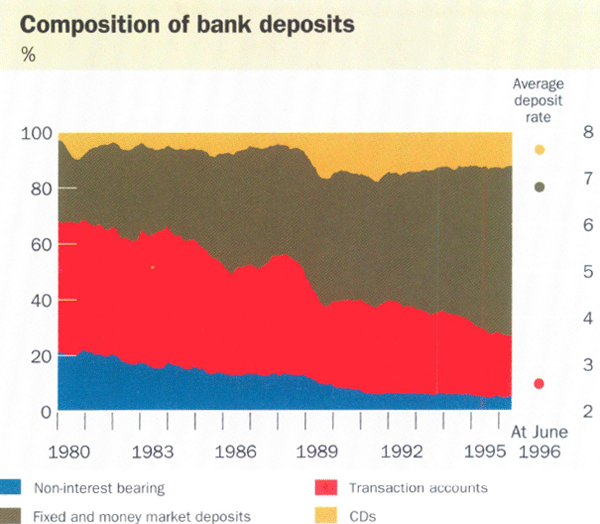
These changes can be seen as another example of the gradual working-through of the effects of two important structural forces, financial deregulation and lower inflation. During the period of regulation, banks and building societies raised the bulk of their deposit funds at interest rates well below market rates. This gave deposit-taking institutions a clear advantage over other institutions which had to obtain funds at market rates. During the 1980s this advantage was gradually whittled away, in the face of competition from new institutions and new products, such as cash management trusts. Even today, however, transaction accounts (including current accounts, passbook, investment savings and pensioner deeming accounts) still represent about a quarter of total bank deposits, on which banks pay an average interest rate of only about 2½ per cent. In addition, no interest at all is paid on about 5 per cent of bank deposits.
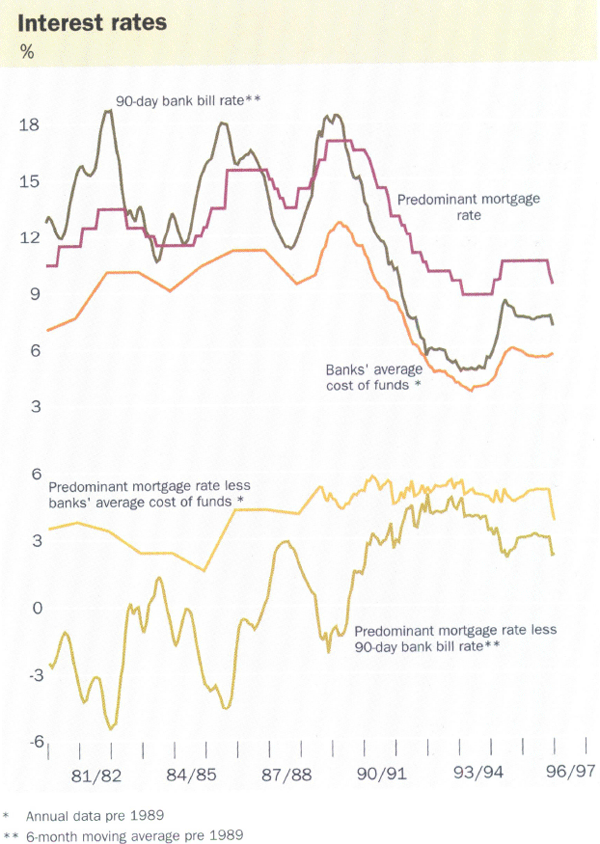
As important as deregulation was, it was not until the fall in inflation in the early 1990s brought a substantial reduction in nominal interest rates, that the advantage of low-cost transactions accounts was reduced significantly. As a result, the gap between banks' cost of funds and the funding costs of their non-deposit-taking competitors narrowed markedly. With banks seeking to maintain their traditional margins, opportunities arose for non-deposit-taking institutions to borrow funds at money market rates and lend them profitably, undercutting banks' lending rates in the process. These competitive forces have taken some time to emerge in the housing loan market, but they are now coming from both new lenders entering the market and from existing lenders introducing new products and trimming margins on existing products. In the same way that cash management trusts brought more vigorous competition for deposit funds in the early 1980s, mortgage originators have brought more intense competition in home loans. All the consequences are yet to work their way through, but they can be expected to cramp the ability of banks to cross-subsidise other activities and maintain recent rates of return.
Banks' margins/spreads
Banks' interest spreads (the difference between average interest received and average interest paid) declined over 1995/96. For the major banks, the average spread on their domestic business fell to 3.8 per cent in the six months to March 1996 (the latest available data) from 3.9 per cent a year earlier. These figures are measured across all interest-earning assets and are therefore held down to some extent by non-performing loans. If average interest received is measured only on performing loans, banks' spreads are higher (3.9 per cent in the six months to March 1996) but again well down on a year earlier. In short, the widening in spreads which occurred in the early 1990s has been fully reversed, and the downward trend evident since deregulation in the 1980s has resumed. The reductions in interest rates on housing loans in mid 1996 are likely to lead to a further narrowing in spreads over the second half of 1996.
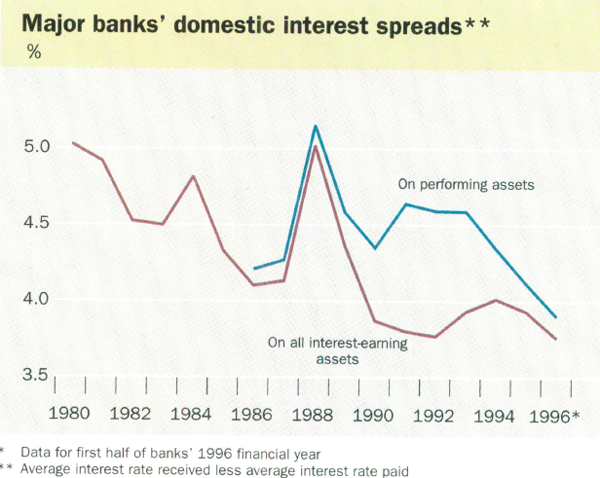
Banks' fees and charges
As pressures on interest margins intensify, banks are looking to reduce the current cross-subsidisation of transactions services by recouping more of the costs of those services directly. In response to the Prices Surveillance Authority's recommendations on fees and charges for retail accounts, several banks have introduced a new basic banking account and/or implemented a modified fee structure for existing retail accounts. The aim has been to encourage customers to consolidate their accounts, and to reduce their usage of costly over-the-counter services.